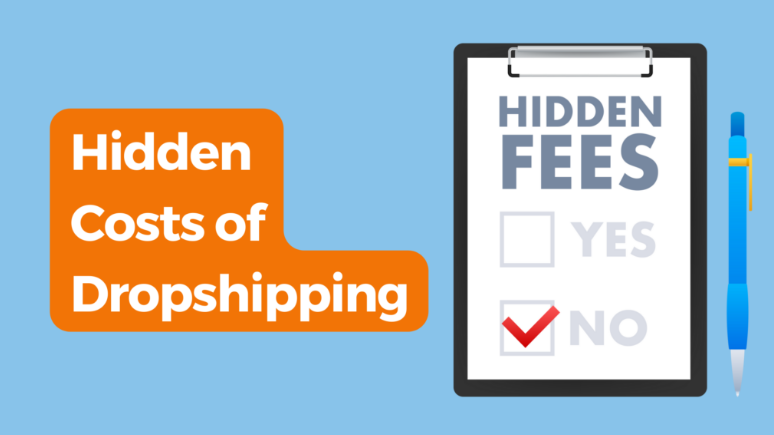
Start a free trial and enjoy 3 months of Shopify for 1 $/month on select plans. Sign up now


At first glance, dropshipping seems like the perfect business model — low upfront investment, no inventory management, and minimal risk. You simply list products, promote them, and let your suppliers handle the rest.
For many entrepreneurs, this simplicity is the dream. But beneath the surface, dropshipping carries a range of hidden costs that can quietly eat away at your profits. From transaction fees to customer returns, from marketing spend to inconsistent supplier pricing, these unseen expenses can turn a promising venture into a financial headache. Understanding these hidden costs — and learning how to minimize them — is essential for building a sustainable, profitable dropshipping business.
Dropshipping is often promoted as a nearly cost-free way to start an online store. While it’s true that you don’t need to invest in inventory or warehouse space, there are many indirect costs that emerge as your store grows. The illusion of “low-cost” dropshipping can mislead new sellers into underpricing their products or overestimating profits.
The key problem lies in perception: while you’re saving on storage and shipping, you’re often paying for the same value in other forms — platform fees, ad costs, return handling, and more. These hidden costs can quickly add up, leaving little room for growth or reinvestment.
A strong dropshipping business must treat these expenses as predictable, manageable parts of the business model — not as surprises.
Every sale made through a dropshipping store carries certain platform or transaction-related costs. Even though they may seem small individually, these fees accumulate over time.
Shopify, WooCommerce, BigCommerce, or other eCommerce platforms typically charge for hosting, themes, and third-party apps. On top of that, payment gateways like PayPal or Stripe take transaction percentages (usually 2.9% + a fixed fee per sale).
While these fees are part of running any eCommerce business, they tend to impact dropshipping stores more heavily because profit margins are already thin.
Small optimizations here can increase your margin without changing your sales volume.
Suppliers determine your product costs — and not all of them are transparent about pricing. Many dropshippers unknowingly overpay due to inflated supplier markups, minimum order policies, or lack of negotiation.
A common mistake is choosing suppliers solely based on convenience or quick onboarding. But unreliable or overpriced suppliers can significantly reduce your profit per order.
Dropshipping profitability relies heavily on consistent supplier relationships. Strong negotiation and constant evaluation are essential to protect your margins.
One of the biggest myths about dropshipping is that shipping is “taken care of” by the supplier. While technically true, you’re still the one paying for it — either directly or through higher wholesale prices.
Shipping costs can vary widely depending on product size, weight, destination, and delivery speed. International shipping can also involve taxes and customs duties that customers expect you to cover.
Reducing shipping delays and surprises doesn’t just save money — it builds trust and repeat sales.
Marketing is often the single largest expense in dropshipping, especially in competitive niches. The idea of “low-cost” marketing quickly disappears when you factor in paid ads, influencer collaborations, or content creation.
New store owners frequently underestimate how much it costs to acquire a single paying customer. Even if your product prices and margins seem attractive, ad costs can easily offset your profits.
Instead of throwing money at ads, smart dropshippers focus on lifetime value — creating experiences that keep customers coming back.
Returns are one of the most overlooked hidden costs in dropshipping. Since you don’t control inventory or product quality, you’re at the mercy of your suppliers. A small error in fulfillment or quality can lead to refunds, disputes, or chargebacks — all of which eat into your profit.
Handling returns also creates administrative costs: processing refunds, communicating with suppliers, and managing customer complaints.
Good customer service is often the cheapest solution. Resolving issues quickly reduces refund requests and maintains your store’s reputation.
As your store grows, you’ll start encountering operational expenses you didn’t expect in the beginning. Even without physical inventory, managing a dropshipping business still involves time, tools, and sometimes outsourced help.
These small steps prevent your “passive business” from turning into a cost-heavy operation.
The secret to success in dropshipping isn’t avoiding costs — it’s controlling them. Every business model has expenses; what separates profitable stores from struggling ones is how well they predict, manage, and minimize them.
To create a sustainable model:
With careful management, dropshipping can evolve from a short-term experiment into a reliable, scalable business.
Dropshipping might promise simplicity, but success depends on seeing beyond the illusion of “cheap and easy.” The hidden costs — from platform fees to shipping, marketing, and returns — can quietly drain profits if left unchecked. Yet, with awareness and smart strategy, these expenses become manageable.
By understanding where money flows, optimizing operations, and building trust with both customers and suppliers, you turn dropshipping from a gamble into a system. The goal isn’t just to sell products — it’s to build a lean, profitable business that grows sustainably. Once you learn to control the unseen costs, the dropshipping model stops being risky and starts being rewarding.